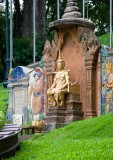 In September, I took a short trip to Phnom Penh. A few years ago I visited Siem Reap in Cambodia’s north to see Angkor Wat, but this was my first time in the capital. I found Phnom Penh to be a confusing mix of experiences: the river front area could have been plucked whole from the tourist streets of Chiang Mai or Phuket, full of pubs, hostels, cafes and tour touts, while the majority of the city is a dusty mass of urban development, neither interested in nor interesting to the backpackers and tourists. The street in which our hotel was located provided a glimpse of a third facet of city life, with small restaurants and shops offering surprisingly expensive organic food and imported wine. I couldn’t tell whether these were intended to cater primarily to Western tourists or wealthy locals.
In September, I took a short trip to Phnom Penh. A few years ago I visited Siem Reap in Cambodia’s north to see Angkor Wat, but this was my first time in the capital. I found Phnom Penh to be a confusing mix of experiences: the river front area could have been plucked whole from the tourist streets of Chiang Mai or Phuket, full of pubs, hostels, cafes and tour touts, while the majority of the city is a dusty mass of urban development, neither interested in nor interesting to the backpackers and tourists. The street in which our hotel was located provided a glimpse of a third facet of city life, with small restaurants and shops offering surprisingly expensive organic food and imported wine. I couldn’t tell whether these were intended to cater primarily to Western tourists or wealthy locals.
Apart from several unappealing museums and memorials to the genocide committed by the Khmer Rouge, I found few landmarks of note, which suited my preference for simply walking around a new city and seeing what I can see. My first walk took me north along the bank of the Tonle Sap, past the Imperial Palace and the Silver Pagoda, to Wat Phnom, beginning in intense heat in the middle of the day and ending in tropical rain in the late afternoon. It seems that Phnom Penh was founded around the hill this way stands upon, with phnom meaning “hill” and Penh being the name of the woman believed to have found the Bhuddist relics that caused the wat to be founded. I wondered at the men standing around the temple with cages filled with small birds, but a bit of research suggests that they offer visitors the opportunity to pay to release them and by doing so earn good karma. Apparently the released birds are typically re-captured later, thus making karma a renewable resource.


















